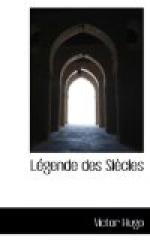Nemrod. See note on PLEINE MER, l.107.
Fenris: the great wolf of Scandinavian mythology whose growth was such that the gods in fear chained him to a rock. Some day his upper jaw will touch the sky, while his lower still rests on earth, and then Odin will tremble for his throne.
le serpent Asgar. This serpent is probably of Hugo’s invention and its name taken from the mythical city of the Scandinavians, Asgard, built by the gods and in which they often resided.
l’archange Attila. This is not the king of the Huns, nor is he one of the known archangels. However, as the Scriptures mention only three archangels, Gabriel, Michael, and Raphael, out of the seven, Hugo may or may not be right in speaking of an archangel of the name of Attila. Le grand chandelier brought from the lower regions by the archangel is merely a poetic fancy and a reminiscence of the seven-branched candlestick of the tabernacle (Exod. XXV. 31-7).
Acteon. Actaeon in Greek mythology was a hunter who saw Diana bathing, and was in consequence changed by the goddess into a stag.
L. 437. chanfrein, the piece of armour which covered the head of the horse.
Les chatons des cuissards sont barris de leurs cles. A difficult line. The chatons were the studs or screws which held the thigh-piece (cuissard) in its place, and the instrument which worked them was called la cle. Barres appears to mean simply ‘fastened’. Sir G.Young translates:—
‘Their cuissart-studs up to the socket braced’
boutoir, the sharp spike on the knee-piece.
crible. The word refers to the visor with seven bars, which was one of the marks of a marquis’s rank.
mortier. The round cap which was the ancient emblem of sovereignty in France. It was worn by barons who possessed full powers of administering justice in their domains, also by the presidents of the ‘parlements’, and by the chancellors. A modified form is still part of the official dress of some of the judges of the highest courts.
It will be noted that the antiquities in this passage are French, not German.
tortil, a ribbon twisted round a crown, the special ornament of a baron, not of a duke. It also signifies in heraldry a circular band or pad to which heraldic negroes’ heads were attached.
rondache, a round shield.
L. 492. The reference is to the coronet of a French marquis, which bore eight jewelled ornaments, four of which consisted each of three great pearls arranged as a trefoil, while the other four were ‘feuilles d’ache,’ the heraldic representation of the leaf of the wild parsley.
hydre: see note on L. 323.
timbre, in heraldry, signifies anything placed above the escutcheon to mark the rank of the person to whom it belonged. Here Hugo seems to use it of the shield, perhaps because the triangular shield was a mark of knightly rank.




